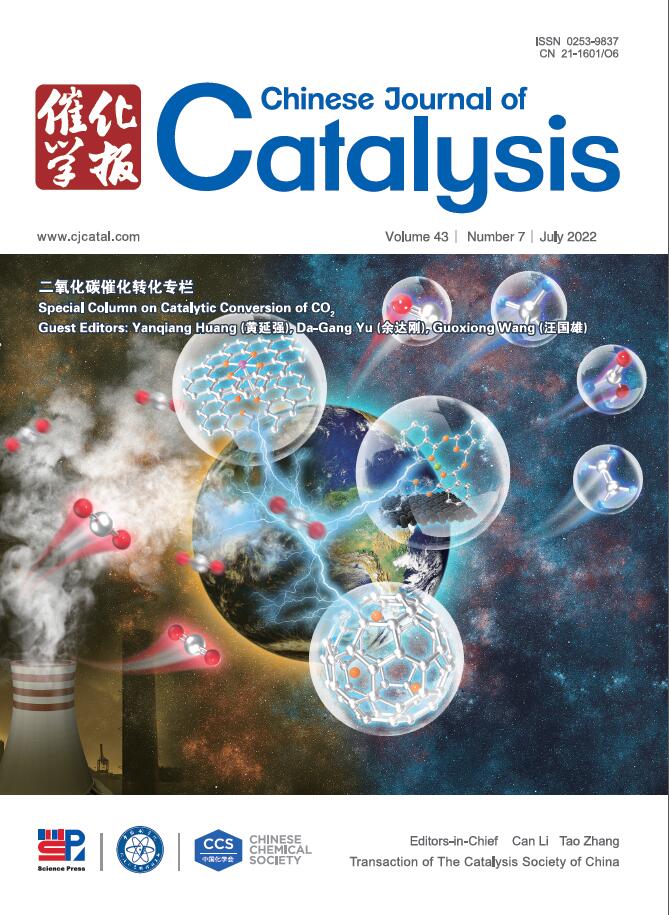S-scheme g-C3N4/BiOBr heterojunction for efficient photocatalytic H2O2 production
IF 17.7
1区 化学
Q1 CHEMISTRY, APPLIED
引用次数: 0
Abstract
The establishment of S-scheme heterojunctions has arisen as a promising strategy for the advancement of efficient photocatalytic systems with superior charge separation and redox ability, specifically for H2O2 production. In this investigation, an innovative 2D/2D g-C3N4/BiOBr S-scheme heterojunction was meticulously engineered through an in situ growth methodology. The synthetic composites exhibit boosted H2O2 production activity, achieving a peak generation rate of 392 μmol L–1 h–1, approximately 8.7-fold and 2.1-fold increase over the pristine BiOBr and g-C3N4, respectively. Such a superior activity should be attributed to the highly efficient charge separation and migration mechanisms, along with the sustained robust redox capability of S-scheme heterostructure, which are verified by time-resolved photoluminescence spectroscopy, photocurrent test and electron paramagnetic resonance measurements. Furthermore, the interfacial electric field induced S-scheme charge transfer mechanism between g-C3N4 and BiOBr is systematically certificated by in situ irradiated X-ray photoelectron spectroscopy and density functional theory calculation. This research offers a comprehensive protocol for the systematic development and construction of highly efficient S-scheme heterojunction photocatalysts, specifically tailored for enhanced H2O2 production.
S-scheme g-C3N4/BiOBr异质结高效光催化生产H2O2
s型异质结的建立已经成为一种很有前途的策略,用于发展具有优越电荷分离和氧化还原能力的高效光催化系统,特别是用于生产H2O2。在本研究中,通过原位生长方法精心设计了一种创新的2D/2D g-C3N4/BiOBr S-scheme异质结。合成的复合材料H2O2生成活性增强,峰值生成速率为392 μmol L-1 h-1,分别比原始BiOBr和g-C3N4提高了约8.7倍和2.1倍。这种优异的活性应归因于高效的电荷分离和迁移机制,以及s -方案异质结构持续强大的氧化还原能力,这是通过时间分辨光致发光光谱,光电流测试和电子顺磁共振测量验证的。此外,通过原位辐照x射线光电子能谱和密度泛函理论计算,系统地验证了界面电场诱导g-C3N4与BiOBr之间S-scheme电荷转移机理。该研究为系统开发和构建高效的s型异质结光催化剂提供了一个全面的方案,专门用于提高H2O2的产量。
本文章由计算机程序翻译,如有差异,请以英文原文为准。
求助全文
约1分钟内获得全文
求助全文
来源期刊

Chinese Journal of Catalysis
工程技术-工程:化工
CiteScore
25.80
自引率
10.30%
发文量
235
审稿时长
1.2 months
期刊介绍:
The journal covers a broad scope, encompassing new trends in catalysis for applications in energy production, environmental protection, and the preparation of materials, petroleum chemicals, and fine chemicals. It explores the scientific foundation for preparing and activating catalysts of commercial interest, emphasizing representative models.The focus includes spectroscopic methods for structural characterization, especially in situ techniques, as well as new theoretical methods with practical impact in catalysis and catalytic reactions.The journal delves into the relationship between homogeneous and heterogeneous catalysis and includes theoretical studies on the structure and reactivity of catalysts.Additionally, contributions on photocatalysis, biocatalysis, surface science, and catalysis-related chemical kinetics are welcomed.
 求助内容:
求助内容: 应助结果提醒方式:
应助结果提醒方式:


